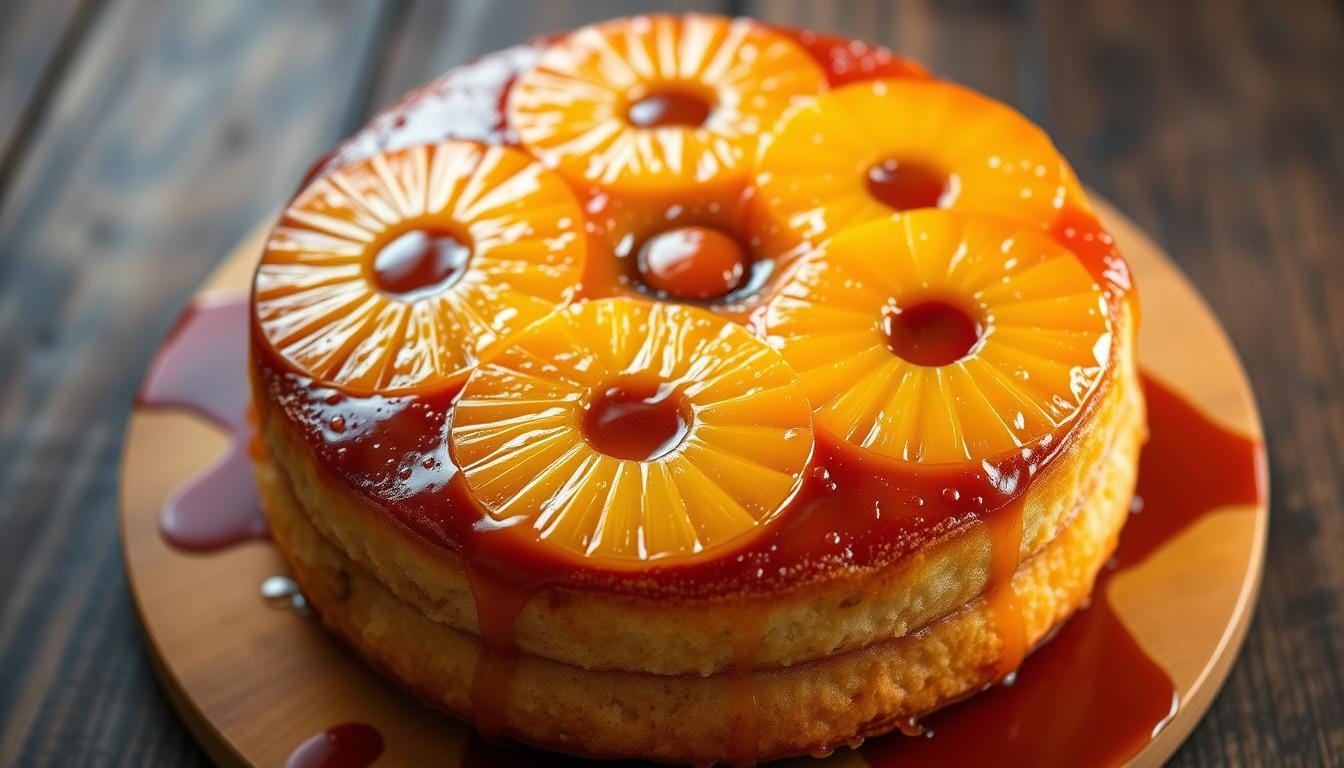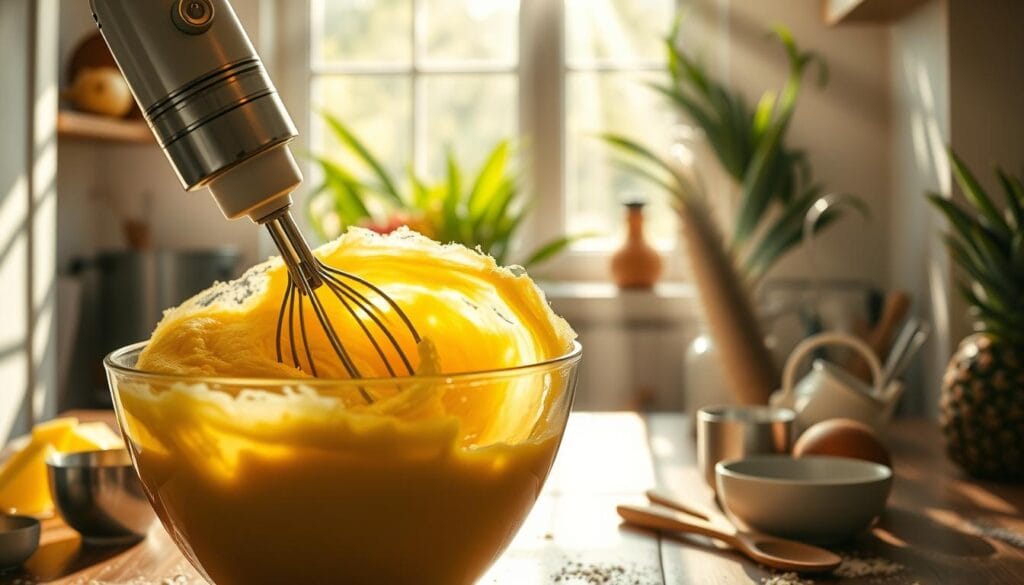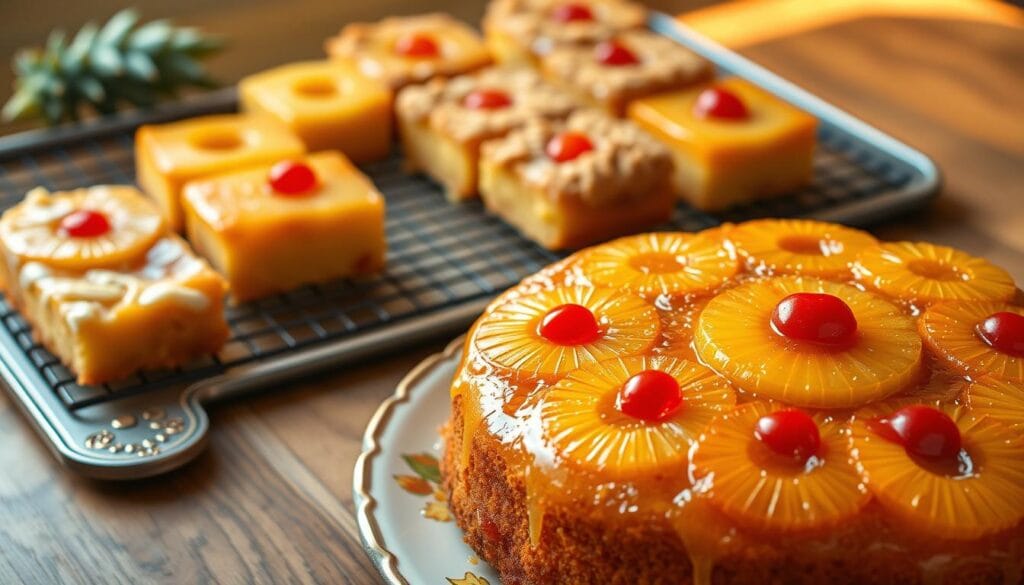Pineapple Upside Down Cake: A Classic Dessert

Pineapple upside down cake has been a favorite for years. Its golden, sticky-sweet topping of caramelized pineapple rings and bright maraschino cherries is unforgettable. When flipped, it reveals a buttery cake soaked in tropical juices.
This cake is more than a dessert. It brings back memories of childhood birthdays and holiday tables. It’s a promise of comfort in every slice.
Table of Contents
The Rich History of Pineapple Upside Down Cake
Discover the story behind the traditional pineapple upside down cake. Pineapples first came to Europe in 1493, after Columbus’s famous voyage. For a long time, they were a rare and expensive fruit.
By the 1920s, thanks to Dole’s canned pineapple, this exotic fruit became common in homes. This change made it easier for people to enjoy pineapple upside down cake.
In the 1930s, pineapple upside down cake became a symbol of hope during the Great Depression. Brands like Betty Crocker and Pillsbury kept it in the spotlight with their ads. Today, its classic look is still loved, showing its lasting appeal.
| Year | Event | Impact |
|---|---|---|
| 1493 | Pineapple discovered by Columbus | Became a status symbol for wealthy households |
| 1920 | Dole begins canning pineapples | Made ingredients accessible for home baking |
| 1925 | Gold Medal Flour’s first recipe published | Launched the cake as a family favorite |
| 1925 | Dole’s recipe contest (2,500+ entries) | Popularized the dish nationwide |
Essential Ingredients for the Perfect Pineapple Upside Down Cake
Choosing the right ingredients is key to a standout pineapple upside down cake. The best recipe balances texture and flavor. Every part, from the pineapple to the cake, is crucial. Here’s what you need for success.
Selecting the Right Pineapple: Fresh vs. Canned
Fresh pineapple adds a burst of acidity but needs peeling and slicing. Look for firm, fragrant fruit. Canned pineapple is sweet and sliced evenly, perfect for a neat look. Make sure to drain it well to avoid soggy layers.
The Perfect Cake Batter Components
- Cake flour makes the crumb tender, unlike all-purpose flour.
- Baking powder and soda help the cake rise, even with heavy fruit.
- Butter and eggs should be at room temperature for smooth mixing.
- Sour cream adds moisture; Duke’s mayonnaise is a unique substitute.
Caramelized Brown Sugar Topping
Mix softened butter and brown sugar until it bubbles. This mixture caramelizes, creating the cake’s signature glaze. Save 2 tablespoons of brown sugar for the topping.
Optional Add-ins to Enhance Flavor
Add coconut flakes for a tropical twist or a pinch of cinnamon. Rum extract or orange zest can add depth without overpowering the pineapple. Maraschino cherries are classic, but dark cherries offer a bolder flavor.
Kitchen Equipment You’ll Need
To make a homemade pineapple upside down cake, you need some basic tools. Start with a 9×13-inch baking dish or a 9-inch round pan. These sizes help prevent overflow and ensure even caramelization.
A glass dish is great for even heat distribution. Metal pans, on the other hand, offer faster browning.
- Baking Dish: Choose between a glass or metal 9×13-inch pan. Cast iron skillets also work for a crispy edge.
- Mixing Essentials: A large mixing bowl (5-quart minimum), electric hand mixer, and whisk ensure smooth batter mixing.
- Measuring Tools: Use glass measuring cups for liquids and measuring spoons for precise sugar and spice measurements.
- Flipping Aids: A cooling rack and heat-safe serving plate let you invert the cake safely.
| Tool | Purpose |
|---|---|
| Electric mixer | Whips butter and sugar quickly |
| Parchment paper | Prevents sticking and simplifies cleanup |
| Baking spatula | Scrapes every bit of batter into the pan |
Even without an electric mixer, a fork or whisk works for manual mixing. Potholders are vital when flipping the hot pan onto a serving platter. For the caramelized topping, a glass dish shows browning progress clearly.
This easy pineapple upside down cake recipe stays approachable—most items are standard kitchen staples. Keep parchment paper and a cooling rack handy to avoid mess during the final flip!
Preparing Your Pineapple Upside Down Cake Batter
Getting the batter right is key. Whether you’re using pineapple cake mix recipes or making it from scratch, follow these steps. This will help you achieve a light, moist cake. For boxed mixes, try using pineapple juice instead of water to boost the flavor in your simple pineapple cake.

Creaming Butter and Sugar: The Foundation of a Moist Cake
Make sure your butter is soft. Beat it with a mixer on high speed until it’s smooth. Then, add sugar and mix until it’s fluffy (about 2 minutes). Scrape the bowl often. For boxed mixes, use pineapple juice instead of water for extra moisture.
- Beat butter and sugar until pale and creamy (1–2 minutes).
- Add vanilla extract and sour cream to the mixture.
Incorporating Eggs and Vanilla
Put in room-temperature egg whites one at a time. Mix until they’re fully incorporated. Don’t overmix after adding eggs to keep the cake tender. Add vanilla extract or vanilla bean paste for a richer flavor.
Mixing Dry Ingredients Properly
Combine dry ingredients in a bowl:
| 1½ cups cake flour | 1 tsp baking powder |
| ¼ tsp baking soda | ½ tsp salt |
Sift to remove lumps. Add to wet ingredients in three parts while mixing on low speed.
Achieving the Perfect Batter Consistency
Stop mixing once everything is just combined. The batter should stick to the spoon but not be too thick. If there are lumps, gently fold them in to fix.
Pro tip: Use the pineapple juice from canned rings to moisten the batter when using boxed mixes. With practice, your simple pineapple cake will turn out perfectly, with even layers.
Creating the Signature Pineapple Topping
Every bite of pineapple in cake starts with a caramelized base. This base is not just for looks; it’s the heart of the cake’s sweetness. Begin by melting 4 tablespoons of butter in a 9×13-inch pan. Then, mix in ½ cup brown sugar.
This mixture will turn into a sticky base. It caramelizes beautifully as it bakes.
Blot the fruit thoroughly before arranging to avoid a soggy cake. Excess moisture can ruin the caramelization.
Arranging Pineapple Rings for Visual Appeal
For the best flavor, use a fresh pineapple cake. Pat pineapple slices dry with paper towels. Then, arrange them in a circle or spiral.
Make sure not to overcrowd the pan. This lets each ring caramelize evenly.
- Symmetry: Line rings around the pan’s edges first.
- Alternatives: Spiral patterns for a modern twist.
- Tip: Trim pineapple ends for even thickness.
Placing Maraschino Cherries for the Classic Look
Place a cherry in the center of each pineapple slice. For a gourmet touch, use homemade glacé cherries instead. Or, try edible flowers or coconut flakes for a tropical look.
Caramelizing Brown Sugar and Butter
Mix melted butter with brown sugar until smooth. Add 1 tsp vanilla and a pinch of salt for extra flavor. The mix should bubble gently but not burn.
Overcooked sugar can taste bitter.
| Tip | How to Apply |
|---|---|
| Moisture Control | Pat fruit dry to prevent soggy layers. |
| Rum Enhancement | Stir 2 tbsp rum into butter-sugar mix for a tropical kick. |
| Storage Hack | Use fresh pineapple for best texture; canned is okay in a pinch. |
Baking Your Pineapple Upside Down Cake to Perfection
First, preheat your oven to 350°F. Grease a 9-inch skillet or pan well. Place the rack in the center for even heat.
Bake the moist pineapple upside down cake for 43–48 minutes. Check with a toothpick in the center. It should have a few moist crumbs. This means the cake is tender but not overcooked.
- Tent foil over the cake halfway through baking to prevent the edges from browning too quickly.
- For extra moisture, insert toothpicks at the pan’s corners before baking. Cover the warm cake with cling wrap while still hot to trap steam.
- Let the cake cool in the pan for 10 minutes before flipping onto a plate—this helps maintain the pineapple ring pattern.
Cast iron skillets give the cake a golden crust. Don’t open the oven too often. This can mess with the cake’s rise. The delicious pineapple upside down cake is done when the edges pull away from the pan.
Serve it warm with whipped cream or vanilla ice cream.
Pro tip: Use canned pineapple in 100% pineapple juice for consistent sweetness. For a tropical twist, add a splash of spiced rum to the batter before baking.
Serving Suggestions and Pairings
When you serve the best pineapple upside down cake, how you present it matters. Here are some tips to make your cake a hit. Let it cool on a wire rack for 20 minutes before flipping. This helps avoid crumbling. Serve it at the perfect temperature with toppings for the best taste.
Best Temperature to Serve: Warm vs. Room Temperature
For a warm slice, cut it right after it cools a bit. The caramel will still flow but might be messy. For cleaner slices, cool it completely at room temperature. Serving it the next day will make the flavors even better. Never put it in the fridge, as it can get too dense.
Complementary Toppings and Garnishes
Here are some ways to make your dessert even better:
- Whipped cream or vanilla ice cream for a cold-heat contrast
- Caramel drizzle or fresh berries (strawberries, raspberries) on top
- Coconut flakes or a dusting of powdered sugar for texture
- Rum-spiked whipped cream for an adult twist
Beverage Pairings That Enhance the Flavor
| Beverage | Pairing Notes |
|---|---|
| Black Coffee | Bold roasts balance sweetness |
| Tropical Cocktails | Piña colada or mojito amplifies pineapple flavors |
| Earl Grey Tea | Earthy notes mirror caramel undertones |
| Sparkling Water | Light acidity cuts richness |
Try lemon sorbet for a tangy contrast or coconut milk ice cream for a tropical vibe.
Delicious Variations of the Classic Recipe
Want to try something new? Check out pineapple cake mix recipes that break the mold. You can go for fresh pineapple cake with a tropical twist or add rum for a modern touch. There’s a version for everyone, from gluten-free to seasonal fruit swaps.

- Tropical Fusion: Add mango slices or kiwi to pineapple. Top with toasted coconut for a beachy vibe.
- Adult Appeal: Mix in 2 tablespoons of rum into the topping or batter. Finish with dark chocolate for a fancy look.
- Dietary-Friendly Options: Use coconut oil instead of butter and a gluten-free pineapple cake mix. Add almond milk for a dairy-free option.
- Seasonal Swaps: Try peaches, berries, or apples instead of pineapple for a taste all year.
Don’t forget to play with textures! Bake fresh pineapple cake as cupcakes or a sheet pan dessert. Or, try the Pineapple Soak Cake for a no-bake treat. Mix in pineapple juice and top with whipped cream. The Yellow Cake with Chocolate Buttercream adds pineapple chunks for extra moisture.
Gluten-free bakers, Bob’s Red Mill 1:1 Gluten-Free flour is your go-to. Vegans, Earth Balance buttery sticks work great. For a tropical boost, add lime zest or coconut extract to the batter.
Conclusion
Homemade pineapple upside down cake is a timeless treat. It combines old charm with new twists. The caramelized fruit topping and soft crumb make it a standout.
This cake is perfect for beginners. It’s easy to make, from arranging pineapple rings to flipping the pan. Just follow the steps.
This dessert has been a favorite in America since the 1920s. It became famous in a 1925 recipe contest. Now, it’s a staple in many kitchens.
It’s celebrated on April 20th every year. You can make it gluten-free or use fresh pineapple. Serve it warm with ice cream or chilled with coffee.
This classic cake is easy to make. It takes under ten minutes to prepare and has minimal cleanup. You can even use a cake mix to make it simpler.
At 373 calories per serving, it’s a sweet treat that’s good for vegetarians. It’s perfect for family gatherings or holidays. Try adding coconut flakes or dark chocolate chips for a twist.
Don’t worry about the caramelized topping. This cake is all about simplicity. It rewards your effort with delicious flavors.
Its legacy spans generations. It shows that classic desserts can be made personal. Bake it for National Pineapple Upside Down Cake Day or a casual brunch. Make it your own.
FAQ
What makes a pineapple upside down cake moist?
A moist pineapple upside down cake comes from the right mix of wet and dry ingredients. Sour cream or yogurt, along with pineapple juices, are key. Not overmixing the batter also helps keep it moist.
Can I use fresh pineapple instead of canned?
Yes, you can use fresh pineapple for a homemade cake. Just cut it into rings and blot excess moisture. This prevents a soggy cake.
What is the best method for caramelizing the sugar for the topping?
To caramelize the sugar topping, melt butter in your baking pan. Sprinkle brown sugar evenly over it. Then, return it to the oven for a few minutes until the sugar is bubbly and slightly golden. This creates a delicious caramel layer.
How do I prevent my cake from sticking to the pan?
To prevent sticking, grease your baking pan well with butter and dust it with flour. You can also line the bottom with parchment paper for extra assurance of easy release.
Are there gluten-free options for pineapple upside down cake?
Yes! Use a gluten-free all-purpose flour blend or a gluten-free cake mix. This way, you can enjoy a delicious gluten-free pineapple upside down cake without losing its classic flavor and texture.
What are some creative variations I can try with this cake?
Try adding different fruits like mango, banana, or peaches. You can also infuse the batter with coconut or rum extract. Seasonal adaptations can celebrate local produce and flavors all year round.
Can I make pineapple upside down cupcakes?
Yes, you can make individual pineapple upside down cupcakes! Use a muffin tin and follow the same topping and batter techniques. Adjust baking time to about 20-25 minutes.
What are some ideal toppings to serve with the cake?
Delicious toppings include freshly whipped cream, vanilla ice cream, or a drizzle of caramel sauce. Toasted coconut is also a great addition that complements the pineapple flavor well.
How did you like the recipe?
There are no reviews yet. Be the first one to write one.
